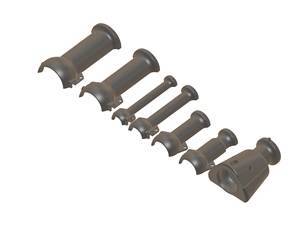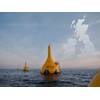Submarine power cables are largely deployed in various offshore renewable energy sources such as wind, wave and tidal installations to transfer power to shore, but also in oil and gas platforms and ocean science observatories. They ensure the power supply to remote areas and by connecting regional electrical transmissions enable global energy trading.
The growing importance of the marine renewable energy sector and the word’s focus on environmental issues have made submarine power cables an infrastructure of critical importance. Most efficient and reliable installation and protection methods are the main concern of engineers and manufacturers.
Basic Characteristics of Submarine Power Cables
There are two basic types of submarine power cables: the HVAC (high voltage, alternating current), limited by transmission distance to less than 80 km but much more cost efficient than the HDVC (high voltage, direct current) for longer distances and for interconnections. The alternating current is transmitted down each of three conductors while the direct current down a primary conductor and requires another conductor or an anode/cathode for the return path. The choice of the cable depends on the route length, voltage, transmission capacity and grid characteristics.
Submarine power cables can reach up to 1,500 mm in diameter depending on current-carrying capacity and amount of armor protection and up to 140 kg/m depending upon type. The amount of armor depends on manufacturer and seabed conditions. Stronger the waves and the currents, more armor is needed.
Why protecting submarine power cables is of critical importance?
The most important reason is obviously the fact that submarine power cables supply energy to remote areas or ensure reliable telecommunications. Having them damaged has a direct impact on people’s life.
Furthermore, installation, maintenance and repair of submarine power cables cost a lot. Damages during installation are quite often and can manifest themselves immediately or even many years later. Once installed, cables are at risk of damage by fishing trawlers and ship’s anchors. It is crucial that the cable laying route is carefully surveyed and selected for minimized environmental impact and maximized cable protection. Undersea cables are subject to damage when not properly installed and not properly protected.
The repair of a damaged submarine power cable is a laborious and expensive process and may last from weeks to many months, depending on damage level, location of the fault and the availability of the ship. During this time the supply of essential services over a wide area will be interrupted. Cable jointing experts are bringing the damaged cable to the surface and are adding a piece of stock cable into the original cable to connect both ends.
Submarine power cables require as well regular maintenance in order to prevent deterioration. This is a costly and challenging activity performed by specialized vessels and it depends heavily on the weather and sea conditions. However, if a cable is proven reliably protected, maintenance can be scheduled differently and interventions minimized.
Conventional Techniques for Submarine Cable Protection
Most of the submarine power cables today are laid in shallow waters less than 500 m depth and are usually buried. For cables in sand areas deeper trenches should be considered. Cable burial delivers reliable protection but it remains a complex technique that may locally disrupt the seabed and form turbid water.
In areas where burial is not possible, the decision for the most appropriate technique is taken based on the surface, installation possibilities and the length and the primary functionality of the cable. Other common practices include concrete mattresses, rock trenching and articulated pipes. However, all existing conventional methods show some disadvantages at certain point, usually in terms of corrosion, cost-efficiency, bending radius, design or fatigue of the electrical conductors.
Aware of the criticality and the importance of this matter, marine renewable energy professionals welcome any new decision that can improve the current situation and deliver reliable submarine cable protection.
An Innovative Solution: Protecting and Ballasting Cast Iron Shells
A European leader in the manufacture of cast iron counterweights for a wide range of industries,
the French foundry FMGC, the casting subsidiary of
Farinia Group, decided to diversify its offer some years ago and apply its expertise in innovative ballast solutions to the Marine Renewable Energy Sector. Since then the company has never seized to invest in new products. The idea for the
cast iron protecting and ballasting shells was born out of the need of the sector to deploy a solution with:
- high level of reliability
- good abrasion and corrosion resistance
- minimized environmental impact
- resistance to withstand all laying and embedment stresses
In 2014, FMGC has launched a collaborative and innovative R&D project in partnership with Innosea (engineering company) and Gem (laboratory of Nantes University and Centrale Nantes) to answer the specific expectations of the Marine Renewable Energy industry. The aim of the project was to develop a full range of articulated cast iron shells that protect, ballast and stabilize subsea conducts (cables, pipes, etc) and semiautomatic installation equipment.
The primary goal of the protecting and ballasting shells is to significantly reduce the cost of the electrical connection for MRE solutions and through it, to reduce the cost of the kWh.
After several months of intense collaboration, the IBOCS consortium designed, manufactured and tested its first shells in February 2015. 40 m of cast iron shells (réf : IBS-70-88) around a 69 mm in diameter electrical cable have been installed near Ushant in the Fromveur, one of the most powerful stream of Europe. Subject to the specific site conditions and the very bad weather (strong storms and tides) the cast iron shells have fully ensured the stability and protection of the electrical cable.
Since then, the company has supplied many shells to different MRE keyplayers and energy companies. The solution can be customized according to the project and the customer’s design requirements.
Why Cast Iron?
Cast Iron has numerous proven advantages for diverse MRE solutions. It is denser than concrete and cast iron corrosion (around 0.25 millimeter per year) is harmless for marine environment due to the low quantities of waste leached. Cast iron is a recyclable material and enables the customized manufacturing of complex parts with high resistance and good machinability.
The Advantages of the Protecting and Ballasting Shells at a Glance:
-Sufficient weight to stabilize the cables
- A hydrodynamic design
- An increase of the bendradius to match that of the cable and the undersea relief
- A transfer of tensile forces during the installation of the cable
- Sufficient mass for the entire duration of the immersion period (20 years minimum)
- A simple, robust and economical design
During installation the cast iron shells:
- Provide extra support for handling or semi-automation to increase the speed of installation
- Minimize the difficulty level of handling
- Improve workplace safety
- Decrease installation costs
The continuously growing importance of the MRE sector but also the word’s need for reliable telecommunications has made submarine power cables infrastructure elements of critical importance. Moreover, climate change may affect marine activities as fishing and expose cables to more natural hazards.
Submarine power cables require a solid investment to be built, installed, maintained, if necessary repaired and are expected to ensure on the long term the transfer of electricity. Better the protection of the cables, less the unexpected cost for repair. To adapt to the high and constantly changing expectations of the sector and to the challenging terrain conditions manufacturers must provide innovative and reliable solutions. Submarine power cables should withstand harsh conditions and environments with limited possibilities of intervention in case of a failure.
The protecting and ballasting shells provide most reliable and robust submarine power cable protection by resisting high impact, abrasion and corrosion. The product is very flexible can be tailored to different types of cables, different weight and different seabed conditions.
The Author
Ralitsa Peycheva is a technical content manager at Farinia Group, interested in forging and casting techniques, latest machinery and tools; curious about new manufacturing methods; respecting high-quality engineering.



















 December 2025
December 2025



